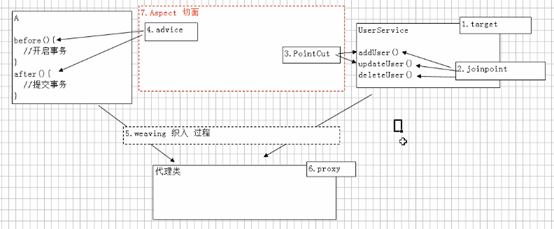****import java.lang.reflect.proxy:*动态代理
Proxy.newProxyInstance(ClassLoader loader, Class<?>[] interfaces,InvocationHandler h)
loader :the class loader to define the proxy
定义真实对象的类加载器
classinterfaces :the list of interfaces for the proxy class to implement
实现代理类的接口列表
h : the invocation handler to dispatch method invocations to
将方法调用到处理程序
具有指定的代理类
调用
处理程序的代理实例,
该代理类
由指定的类加载器定义
并实现指定的接口
//返回代理类的一个实例,返回后的代理类可以当作被代理类使用(可使用被代理类的在Subject接口中声明过的方法)。
return Proxy.newProxyInstance(/* */
// 参数1:真实对象的类加载器
myBeanpostProcessor.class.getClassLoader(),
//参数2:真实对象实现的所有的接口,接口是特殊的类,使用Class[]装载多个接口
bean.getClass().getInterfaces(),
//参数3: 接口,传递一个匿名内部类对象
new InvocationHandler() {
//proxy 代理对象
//method:代理的方法对象
//args:方法调用时参数
public Object invoke(Object proxy, Method method, Object[] args) throws Throwable {
System.out.println("开启事务");
Object obj=method.invoke(bean, args);//代理类,参数
System.out.println("关闭事务");
return obj;
}
});/* */
}
}
分割线--------------------------------------------------------------------------------------------------------------------
前面是开发文档的意思,让人比较难理解。我用自己的话对AOP中的动态代理进行解释

我想对UserService类中的方法,每一个都添加开启事务和提交事务的方法。
但是又不改动UserService,所以采用了AOP思想
用Spring生成了一个UserService的代理类,可以调用UserService的方法,也可以把事务类的方法添加到代理类中。完成了我们想要的情况。
经典应用:事务管理,性能监控,安全检查,缓存,日志。
接口+实现类,Spring采用JDK的动态代理Proxy
实现类:Spring采用cglib字节码增强
AOP的术语
1.Target Object(目标对象):需要被代理的类 例如:UserService
2.Joinpoint(连接点):那些可能被拦截的方法 例如:UserService中的所有方法
3.Pointcut(切入点):是指已经被增强的方法 例如:addUser()
4.Advice(通知/增强处理):增强代码 例如:befor(),after()
5.Weaving(织入):将切面代码插入到目标对象上,从而生成代理对象的过程
6.Proxy(代理):动态创建的代理类
7.Aspect(切面):advice通知和Pointcut切入点组成的面
一条线是一个特殊的面
一个advice通知的点和Pointcut切入点组成的特殊的面

//切面类Aspect
public class MyAspect {
public void befor() {
System.out.println("开启事务");
}
public void after() {
System.out.println("事务提交");
}
//目标类Target
public interface UserService {
public void addUser();
public void deleteUser();
}
//实现类
public class UserServiceimpl implements UserService {
public void addUser() {
System.out.println("添加用户成功");
}
public void deleteUser() {
System.out.println("删除用户成功");
}
}
import java.lang.reflect.InvocationHandler;
import java.lang.reflect.Method;
import java.lang.reflect.Proxy;
//工厂类
public class MyBeanFactory{
public static UserService CreateUserService() {
// 目标类
// addUser() <--开辟了一个实现类的堆给他
UserService userService=new UserServiceimpl();
// 切面类Aspect
MyAspect myAspect=new MyAspect();
// 代理类:将目标类(切入点)和切面类(通知)结合-->切面
// Proxy.newProxyInstance
// 参数1:loader,类加载器,动态代理类,运行时创建,如何类都需要类加载器将其加载到内存
// 一般情况:当前类.class.getClassLoader();
// 目标类实例.getClass().getClassLoader();
// 参数2:Class[] interfaces 代理类需要实现的所有接口
// 方式1:目标类实例.getClass.getInterfaces();注意:只能获得自己的接口,不能获得父类元素接口
// 方式2:new class[]{UserService.class}
// 参数3:InvocationHandler() 处理类,接口,必须进行实现类,一般采用匿名内部
// 提供invoke方法,代理类的每一个方法执行时,都将调用一次invoke
// 参数31:Object proxy:代理对象
// 参数32:Method method:代理对象当前执行的方法的描述对象(反射)
// 参数33:Object[] args:方法实际参数
UserService proxySvice=(UserService) Proxy.newProxyInstance(
MyBeanFactory.class.getClassLoader(),
userService.getClass().getInterfaces(),
new InvocationHandler() {
@Override
public Object invoke(Object proxy, Method method, Object[] args) throws Throwable {
myAspect.befor();//事务开启
Object obj=method.invoke(userService, args);
myAspect.after();//事务提交
return obj;
}
});
return proxySvice;
}
}
最后就是测试类
import org.junit.Test;
//测试类
public class AopText {
@Test
public void demo() {
UserService userService=MyBeanFactory.CreateUserService();
userService.addUser();
userService.deleteUser();
}
}
输出结果

分割线------------------------------------------------------------------------------------------------
不懂的可以在评论问我。。。。。
最后
以上就是耍酷星月最近收集整理的关于对Proxy.newProxyInstance的一些理解的全部内容,更多相关对Proxy.newProxyInstance内容请搜索靠谱客的其他文章。








发表评论 取消回复